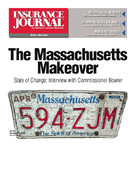Community banks have come a long way since Jimmy Stewart’s character struggled to keep the Bailey Building and Loan alive to support the residents in Bedford Falls in Frank Capra’s 1946 classic “It’s a Wonderful Life.”
Insuring these institutions has also evolved beyond the point of keeping the $8,000 cash deposit out of the greedy hands of Mr. Potter.
Community banks have become a trusted link in the chain of financial institutions and an opportunity for a dedicated insurance agent to play a role in the stability of their own community.
The definition of a community bank differs depending on whom is being asked. Generally, a community bank is a financial institution that is not included in the narrow spectrum of the few mega-banks or the dozen regional banks across the country.
According to Rich Look of Venture Programs, a community bank has less than $2 billion in assets. His average community bank prospect has no more than 20 branches and total deposits of somewhere between $50 and $125 million.
Venture Programs offers a banking program through Chubb for institutions with assets under $1 billion. For assets between $1 and $2 billion, Look said Venture would attempt to place the risk with a division of Hartford.
Dan Clancy, the director of services at the Independent Community Bankers of America (ICBA) explained that the average member of his trade organization had $167 million in assets in 2003 and commonly employs less than 25 employees. The number of branches at community banks are normally limited to 10 locations or less.
“Many community banks have been owned by the same family, or the same limited group of investors for generations,” Clancy said. “That usually means that the same agent or agency has been responsible for the bulk of insurance for many years.”
In that sense, insuring a community bank has really not changed since the Depression Era and bank runs that haunted George Bailey at the old Building and Loan.
Director’s and officers coverage (D&O) remains one of the essential commodities of an umbrella package for a community bank. D&O can also be one of the most volatile liabilities when family feuds and personality conflicts create precarious situations.
“It’s really no different than any other private-held company,” Gary Erickson explained, the assistant vice president of financial institutions at St. Paul Travelers. “The board of directors can be members of a single family, leading members of the local business community or a just a member of the local Kiwanis Club. Often times the owner of a community’s insurance agency can have a place on the board of one or more banks in the same town.”
Relationships are the secret
Relationships remain the key to being in the right position to write insurance for a community bank, according to Erickson’s colleague Richard Lacy, the director of business development for financial and professional services at St. Paul Travelers. Lacey said friendships or a seat on the board of directors are far more important than individual levels of deposits.
Lacy added that insurance brokers who have more expertise in other areas of insurance often rely on strength of their underwriters to secure business at a community bank.
“An independent agent can relate to the everyday challenges that community banks face when confronted with competition from the bigger regional and mega-banks,” Lacy said. “If the agent who has a seat on the board cannot provide this type of coverage, he or she can serve as a consultant and help determine the best value from the options available.”
Paul Weil, board member and general council for Southwest Community Bank in San Diego, added that relationships are critical for smaller institutions.
Erickson added that a single agent could not be expected to be an expert on every area of coverage for a community bank. He went on to way that a town with one or two banks may not provide enough financial incentive or accessibility for an agent to develop expertise in that area.
“Big brokers may have the expertise, but not the relationship that is required to serve a community bank,” Erickson concluded.
The ICBA and the American Community Bankers (ACB) have endorsed coverage from St. Paul Travelers. The company began its relationship with community banks in 1890 and provided bonds for smaller financial institutions starting with the Stock Market Crash in 1929.
The leader in the community bank market works exclusively with independent agents. Coverages include: D&O liability; employment practices liability; bankers professional liability, including lender liability; crime (financial institution bond); fiduciary liability; trust errors and omissions liability; kidnap and ransom; Internet liability; e-commerce extortion threats; computer property; general liability; auto liability; workers’ compensation; and property.
Of the 27,000 financial institutions in the U.S. registered with the Federal Deposit Insurance Corporation (FDIC), more than 25,000 have less than $2 billion in assets. That number also includes credit unions and savings and loans.
Good business
Statistical trends issued by the FDIC indicate that insuring banks
Recent bank failures peaked in 1990 when 169 institutions closed their doors. The number dropped to double digits within three years. Over the past decade, the number of bank failures has averaged only four per year.
More than 200 savings and loans failed in 1990 at the height of the savings and loan scandal. But the FDIC reports that the number of failed savings and loans has not topped two per year in more than a decade.
Bank mergers hit a high of 606 in 1995. The merger frenzy ended and the number of mergers continued to drop until hitting a low of 226 in 2003. There were less than 130 mergers on the books through October of this year.
“The local bank is a very prestigious account for a local agent,” Venture Programs’ Look said. “Prestige is important, but you can’t take it to the bank.”
Annual premiums for community bank coverage range between $25,000 and $75,000, according to Look.
“But the competition is less intense with the smaller accounts because most agents are attracted by the slim chance of hitting the jackpot that comes with picking up a slice of the business from the bigger regional or mega-banks,” Look said.
Look added that many larger institutions have the strength to leverage heavily discounted coverage. He added that many of the mega-banks have the capacity to remain self-insured.
Community banks have matured during the past generation, expanding services to rival many of the larger financial institutions. The biggest difference between the larger banks and community institutions remains the wide variety of financial and insurance services offered by the larger banks, according to the representatives from St. Paul Travelers.
For the insurance agent, that translates into lower risk and customized coverages for the community bank market.
A survey of 921 community banks taken in 2002 determined that approximately 45 percent of the smaller institutions have obtained extra liability coverage related to their Websites and online banking. The survey was co-sponsored by the American Bankers Association Community Bankers Council and the ABA Banking Journal.
The survey also found that community banks have increased coverage in eight different forms of coverage, specifically various areas of liability. Almost 60 percent of those surveyed increased coverage for the institution’s financial bond, more than 32 percent obtained more coverage in their general liability policies, 20.8 percent added protection for electronic data processing and internal systems, while 17.8 percent upped coverage for external systems.
Many of the community banks also added coverage for business interruption (13.3 percent), business interruption for customers (7.8 percent), media liability (4.4 percent) and data ransom protection (3.8 percent).
Results from the surveys also indicated that almost half of the community banks have found the Web sites to be running at a loss, but almost the same number expected online banking to be profitable in the near future.
Geographically, the survey uncovered that half of the banks in the West selected the optional Web site coverage, while the numbers in the central and eastern regions fell below 40 percent (39.1 percent).
De novo
The industry name for these new community banks is de novo. According to Erickson and Lacy from St. Paul Travelers, many bank managers and executives absorbed by mergers with regional and mega institutions have been instrumental in founding their own community banks.
“More than 90 percent of our de novo clients are from former employees or executives of community banks who felt ‘out of place’ in the structure mandated by the larger institutions,” Erickson said. “Customers and clients missed the intimate feel of the community bank.”
Camden R. Fine, the incoming president and CEO of the ICBA, said his newest members will need access to a wide range of insurance innovations in the coming years to keep up with increased competition from credit unions and smaller savings and loans.
Statistics from the FDIC indicate that new charters peaked in 1999 and 2000. The numbers show a direct relationship to the mergers that took place in the previous few years.
Special needs
In addition to the policies issued through Venture Partners, The Chubb Group of insurance companies has targeted the fast-growing community bank market. After 30 years of insuring larger banks, Chubb targeted the community bank market as a direct result of the numerous banks being created as an indirect result of the many bank mergers and acquisitions. Chubb decided to enter the fast-growing market at approximately the same two-year period by offering protection for institutions with assets below $1 billion.
“It is an area Chubb can realize some growth in,” said James Ostrom, the former assistant vice president for Chubb in Warren, NJ. “The larger banks are merging and reducing in number.”
Ostrom explained that Chubb has attempted to meet the special needs of community banks, singling out policies that offer workplace violence coverage that protects against violent behavior as a result of robberies as well as incidents between co-workers.
Chubb’s community bank program offers three core products that integrate distinct levels of coverage. The protection ranges from fiduciary liability and employment practices, to security related losses and custom-tailored protection for machinery.
American International Cos., a subsidiary of New York-based AIG, recently introduced a program designed for community banks, credit unions and savings and loan institutions with assets under $1 billion. The program combines management and professional liability coverages.
The Community Bank Protector offered through AIG allows the banking client to select from liability protection for D&O, employment practices, banker’s professional, lenders liability as well as kidnap and ransom coverage. Limits of liability are available up to $25 million.
The New York-based division of CNA Financial also recently launched insurance programs aimed expressly for community banks. The Financial Institution Executive Risk program offers enhanced coverage for community banks featuring multiple coverages based on variable limits.
The CNA program features enhanced D&O coverage as well as options for bank bond, fiduciary liability, errors and omissions coverage designed for trust departments. It also provides additional protection for E&O that cover retirement savings programs. CNA has offered insurance protection for community banks for more than a decade.
“The combined weight of regulations and competition is pressing down on community banks,” Fine said, comparing the burden to the proverbial straw that broke the camel’s back. “The largest banks can spread the burden across a wide area. Most community banks only have a few employees who do multiple jobs and are struggling to keep up.”
One innovation is the likihood of community banks joining together when shopping for insurance, according to Weil of Southwest Community Bank.
The corporate attorney was quick to stress that the convergence of community banks was for purchasing power only and in no way indicated the start of merger negotiations. Southwest Community Bank currently has 10 locations, in addition to its corporate office in Carlsbad, Calif.
“Various forms of liability insurance are a necessity at every bank,” Weil said. “But newer banks need the leverage of getting the pricing down to realistic levels so we can continue to provide the local service at a competitive price.
“That was the inspiration behind the creation of most community banks.”
Adequate insurance would have eliminated the need for angel-second class Clarence to visit George Bailey in Bedford Falls. But professional liability and D&O coverage for community banks would have taken away an opportunity for an angel to earn his wings.
Was this article valuable?
Here are more articles you may enjoy.


 Cracks in O’Hare Columns Aren’t Insured Property Damage, Just Bad Product – Court
Cracks in O’Hare Columns Aren’t Insured Property Damage, Just Bad Product – Court  Berkshire’s Jain on Cyber: ‘The Mindset Should Be You’re Not Making Money’
Berkshire’s Jain on Cyber: ‘The Mindset Should Be You’re Not Making Money’  Berkshire’s ‘Most Important’ Biz Drives Q1 Results; GEICO Still Behind on Tech
Berkshire’s ‘Most Important’ Biz Drives Q1 Results; GEICO Still Behind on Tech  Southeast Seas Rising Faster Than Other Regions, ‘Turbocharging’ Floods, Report Finds
Southeast Seas Rising Faster Than Other Regions, ‘Turbocharging’ Floods, Report Finds 


